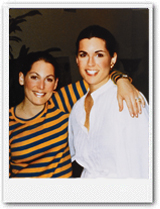 On Wednesday, I posted the story of Susan G. Komen as told by her younger sister, Nancy Brinker. I thought a follow up from Nancy was fitting. If by some crazy chance you didn’t see Wednesday’s post, I’ll refresh you with how Nancy ended it, she asked this question.
On Wednesday, I posted the story of Susan G. Komen as told by her younger sister, Nancy Brinker. I thought a follow up from Nancy was fitting. If by some crazy chance you didn’t see Wednesday’s post, I’ll refresh you with how Nancy ended it, she asked this question.
“Can one person really make a difference?”
Here are Nancy’s follow up thoughts in a letter from the non-profit she founded, Susan G. Komen for the Cure:
As I look back over the more than 25 years since I founded Susan G. Komen for the Cure, I am amazed at our accomplishments. What began as a promise to my dying sister, Susan G. Komen, has evolved into the world’s largest grassroots network of breast cancer survivors and activists fighting to save lives, empower people, ensure quality care for all and energize science to find the cures.
I am in awe of our victories over the last three decades. Thanks to research, the breast cancer death rate in the U.S. has fallen by more than 30% in 20 years. Five-year relative survival rates for women with early stage cancers (before they’ve left the breast) are at 99% (up from 74%when we started). Most importantly, women today know that they are never alone with breast cancer, as they were when Suzy was diagnosed. There is a global community, millions strong, sharing our victories, fighting for us and working together to end a dreadful disease.
We began the global breast cancer movement with $200 and a shoebox full of names in my living room in 1982. We have since built a global community of scientists, advocates, neighbors and friends, working together to make this disease a distant memory.
I thank all of our friends and supporters for making so much possible. Thanks to you, Susan G. Komen for the Cure has invested more in breast cancer research than any other organization – $685 million to date.
We have fought for access to care for the poor and uninsured; funded the clinics that educate, screen and treat people with breast cancer; paid for the groceries, transportation, wigs, prosthetics and insurance co-pays to help women face breast cancer with dignity and hope. We are doing this in more than 50 countries around the world, with more to come. We have invested more than $1.3 billion to make these programs possible.
With the help of Komen Affiliates, corporate partners, individual donors, Komen staff and activists, we’ve saved millions of lives, making the 2.5 million breast cancer survivors in the U.S. the largest group of cancer survivors today.
The sad reality is there is still tremendous work left to do. We don’t know – yet – why breast cancer starts. We don’t know enough about how to prevent it. A woman dies of breast cancer every 74 seconds somewhere in the world: about half a million will die of breast cancer this year alone.
We know that we can change those numbers because we have already changes the reality of breast cancer for the better for so many women. Thank you for making the first three decades years of progress, community and hope. Let’s make the next 30 years the generation for cures for the most aggressive forms of breast cancer, and for making those cures available to women everywhere.
Together, I know we can fulfill our Promise to every woman, man and family.
With love and gratitude,
Ambassador Nancy G. Brinker
Founder and CEO
I don’t know, what do you think? Can one person make a difference?
Charity Matters.
Copyright © 2012 Charity Matters. This article may not be reproduced without explicit written permission; if you are not reading this in your newsreader, the site you are viewing is illegally infringing our copyright. We would be grateful if you contact us.


